Pentagonal hexecontahedron
| Pentagonal hexecontahedron | |
|---|---|
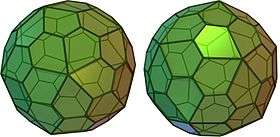 (Click here for rotating model) | |
| Type | Catalan solid |
| Coxeter diagram | |
| Conway notation | gD |
| Face type | V3.3.3.3.5 irregular pentagon |
| Faces | 60 |
| Edges | 150 |
| Vertices | 92 |
| Vertices by type | 12 {5} 20+60 {3} |
| Symmetry group | I, 1/2H3, [5,3]+, (532) |
| Rotation group | I, [5,3]+, (532) |
| Dihedral angle | 153°10′43″ |
| Properties | convex, face-transitive chiral |
 Snub dodecahedron (dual polyhedron) |
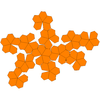 Net |
In geometry, a pentagonal hexecontahedron is a Catalan solid, dual of the snub dodecahedron. It has two distinct forms, which are mirror images (or "enantiomorphs") of each other. It is also well-known to be the Catalan solid with the most vertices. Among the Catalan and Archimedean solids, it has the second largest number of vertices, after the truncated icosidodecahedron, which has 120 vertices.
Geometry
The faces are irregular pentagons with two long edges and three short edges. The ratio of edge lengths is about 1:1.7489525667362. The faces have four obtuse angles of about 118.13662 degrees each, and one acute angle (between the two long edges) of about 67.45351 degrees. The dihedral angle is about 153.178732558 degrees between all faces.
Note that the face centers of the snub dodecahedron cannot serve directly as vertices of the pentagonal hexecontahedron: the four triangle centers lie in one plane but the pentagon center does not; it needs to be radially pushed out to make it coplanar with the triangle centers. Consequently, the vertices of the pentagonal hexecontahedron do not all lie on the same sphere and by definition it is not a zonohedron.
Construction
The pentagonal hexecontahedron can be constructed from a snub dodecahedron without taking the dual. Pentagonal pyramids are added to the 12 pentagonal faces of the snub dodecahedron, and triangular pyramids are added to the 20 triangular faces that do not share an edge with a pentagon. The pyramid heights are adjusted to make them coplanar with the other 60 triangular faces of the snub dodecahedron. The result is the pentagonal hexecontahedron.[1]
Orthogonal projections
The pentagonal hexecontahedron has three symmetry positions, two on vertices, and one mid-edge.
| Projective symmetry |
[3] | [5]+ | [2] |
|---|---|---|---|
| Image |  |
 |
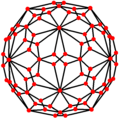 |
| Dual image |
 |
 |
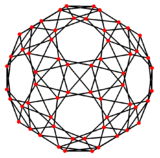 |
Related polyhedra and tilings
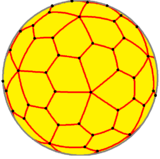
| Family of uniform icosahedral polyhedra | |||||||
|---|---|---|---|---|---|---|---|
| Symmetry: [5,3], (*532) | [5,3]+, (532) | ||||||
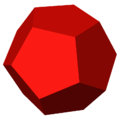 |
 |
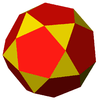 |
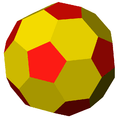 |
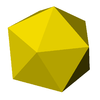 |
 |
 |
 |
| {5,3} | t{5,3} | r{5,3} | t{3,5} | {3,5} | rr{5,3} | tr{5,3} | sr{5,3} |
| Duals to uniform polyhedra | |||||||
 |
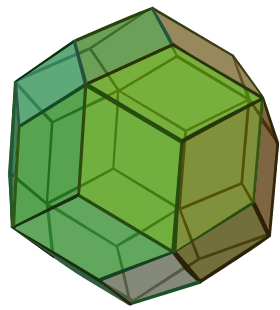 |
 |
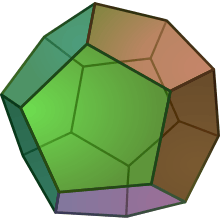 |
 |
 | ||
| V5.5.5 | V3.10.10 | V3.5.3.5 | V5.6.6 | V3.3.3.3.3 | V3.4.5.4 | V4.6.10 | V3.3.3.3.5 |
This polyhedron is topologically related as a part of sequence of polyhedra and tilings of pentagons with face configurations (V3.3.3.3.n). (The sequence progresses into tilings the hyperbolic plane to any n.) These face-transitive figures have (n32) rotational symmetry.
| n32 symmetry mutations of snub tilings: 3.3.3.3.n | ||||||||
|---|---|---|---|---|---|---|---|---|
| Symmetry n32 |
Spherical | Euclidean | Compact hyperbolic | Paracomp. | ||||
| 232 | 332 | 432 | 532 | 632 | 732 | 832 | ∞32 | |
| Snub figures |
 |
 |
 |
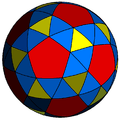 |
 |
 |
 |
 |
| Config. | 3.3.3.3.2 | 3.3.3.3.3 | 3.3.3.3.4 | 3.3.3.3.5 | 3.3.3.3.6 | 3.3.3.3.7 | 3.3.3.3.8 | 3.3.3.3.∞ |
| Gryro figures |
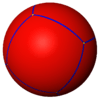 |
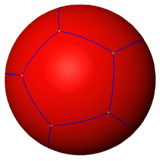 |
 |
 |
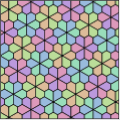 |
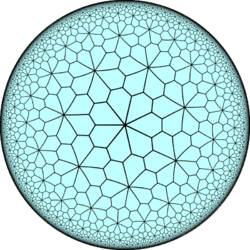 |
 | |
| Config. | V3.3.3.3.2 | V3.3.3.3.3 | V3.3.3.3.4 | V3.3.3.3.5 | V3.3.3.3.6 | V3.3.3.3.7 | V3.3.3.3.8 | V3.3.3.3.∞ |
References
- Williams, Robert (1979). The Geometrical Foundation of Natural Structure: A Source Book of Design. Dover Publications, Inc. ISBN 0-486-23729-X. (Section 3-9)
- Wenninger, Magnus (1983), Dual Models, Cambridge University Press, ISBN 978-0-521-54325-5, MR 730208 (The thirteen semiregular convex polyhedra and their duals, Page 29, Pentagonal hexecontahedron)
- The Symmetries of Things 2008, John H. Conway, Heidi Burgiel, Chaim Goodman-Strass, ISBN 978-1-56881-220-5 (Chapter 21, Naming the Archimedean and Catalan polyhedra and tilings, page 287, pentagonal hexecontahedron )
External links
- Eric W. Weisstein, Pentagonal hexecontahedron (Catalan solid) at MathWorld.
- Pentagonal Hexecontrahedron – Interactive Polyhedron Model